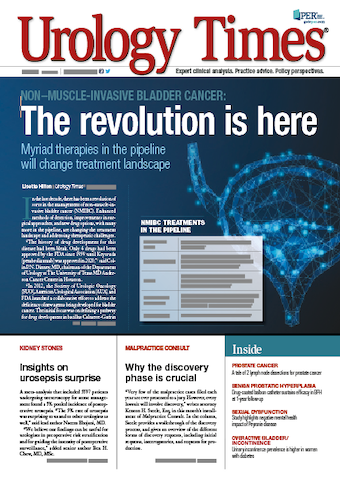Publication
Article
Urology Times Journal
A tale of 2 lymph node dissections for prostate cancer
Author(s):
"Three decades into prostate-specific antigen screening–detected prostate cancer, the prognostic and therapeutic impacts of various types of pelvic lymph node dissection remain unclear," writes Badar M. Mian, MD.
Badar M. Mian, MD

Due to the low sensitivity of imaging studies, pelvic lymph node dissection (PLND) remains the most effective method for staging of prostate cancer. Due to paucity of randomized controlled trials (RCT), the role of various PLND templates, in terms of prognostic and therapeutic benefits, has remained controversial. Some experts believe that standard or limited PLND (LPLND) is sufficient for staging whereas others strongly support the use extended PLND (EPLND) for its potential to remove more lymph nodes and micrometastases. Two recently reported RCTs within the past 6 months are now available to illuminate this subject. The RCT by Lestingi et al1 was detailed here a few months ago.2
Now, Touijer et al3 report the results of an RCT that was designed to address the questions regarding the therapeutic benefits (ie, biochemical recurrence [BCR]-free survival) of EPLND compared to LPLND. From October 2011 to March 2017, of 1477 men undergoing radical prostatectomy and bilateral PLND, 700 men were randomized to the LPLND template and 740 to the EPLND template group. Instead of individual patient randomization, a cluster randomization strategy was employed for ease of consent and logistics of trial execution. The surgeons were cluster-randomized every 3 months to perform either LPLND or EPLND. Two surgeons were removed from the study in June 2015 for poor compliance with the randomized assignments.
Of the randomized patients, no PLND was performed in 42 and 55 patients in the LPLND and EPLND groups. Thirty-seven patients were excluded either due to withdrawal of consent (8) or being lost to follow-up (29). The distribution of biopsy Gleason scores (GS) in the LPLND and EPLND groups was 18% and 22% for GS of 8 or higher, 19% and 17% for GS 4+3, 52% and 52% for GS 3+4, and 10% and 9.4% for GS 6, respectively.
In terms of lymph node yield, a median of 12 lymph nodes were removed in the LPLND group compared with 14 in the EPLND group. The rate of lymph node metastasis (pN1) was 12% in the LPLND arm and 14% in the EPLND arm (P=.3).
After a median follow-up of 3.1 years, 388 (26.9%) BCR events occurred in the entire cohort. Regardless of how the data were analyzed, there was no difference in the BCR rates between the LPLND or EPLND (P=.5) groups. Overall, the rates of Clavien-Dindo grade 2 and grade 3 complications (including deep vein thrombosis or lymphocele) were similar in the LPLND and EPLND groups at 7.3% and 6.4%, respectively. There were no grade 4 or 5 complications.
Similar lack of therapeutic effect of EPLND was noted in another RCT reported by Lestingi et al a few months ago. Although these 2 trials cannot be compared directly, there are several baseline differences amongst the trials worthy of consideration. The current trial was sufficiently powered with 1477 patients, compared with 300 patients in the earlier study. One main difference among the trials was in the EPLND template. The earlier trial by Lestingi et al included the common iliac nodes in the EPLND template, which yielded median 17 lymph nodes, but not in the current trial, which yielded median 14 lymph nodes. Conversely, the median lymph node count with LPLND in the current trial was much higher than in the earlier trial (12 vs lymph nodes 3 lymph nodes, respectively), and the rate of pN1 in the LPLND group was 12% in the current trial and only 3.4% in the earlier trial. Other nonrandomized series of PLND have demonstrated different results than the current trial, showing an increased number of lymph nodes with EPLND, and increase in the rate of pN1, according to John W. Davis, MD, of The University of Texas MD Anderson Cancer Center in Houston.
Although studies have reported variability in the correlation between more lymph nodes removed and higher rate of pN1, none have demonstrated a difference in BCR rates between LPLND and EPLND groups. Further, the benefit of any PLND in patients with intermediate-risk prostate cancer, which comprises the majority cohort in both of the RCTs, is subject to debate. A recent report by Altok et al evaluated the impact of omitting the PLND in cases with biopsy GS of 3+4 or lower, T1-2 who are subsequently upgraded to prostatectomy GS 4+3 or lower, or stage pT3.4 They noted that omission of PLND in appropriately matched cases did not alter the rate of BCR compared with those who underwent PLND (regardless of template). The current trial did not report the outcome of 97 patients in whom a PLND was omitted.
The authors of this RCT reported that the complication rates were similar in the LPLND and EPLND groups, which is similar to what has been reported by other nonrandomized studies, and is reflective of this author’s experience. Yet a recent large, systematic review and meta-analysis of this subject suggests otherwise. A study by Cacciamani et al reviewed 176 studies (77,303 patients) undergoing PLND.5 Intraoperative complications were noted in 1.8% and postoperative complications in 14.1%. The limited or standard PLND group experienced fewer complications (risk ratio, 0.55; P=.01), especially lymphoceles and thromboembolic events, when compared with EPLND. EPLND was an independent predictor of increased complications, especially lymphocele formation (risk ratio, 1.77; P<.001).
When comparing this trial with other studies, the median lymph node count in the LPLND cohort were higher, and in the EPLND cohort was lower than expected. The lymphatic and fibrofatty tissue removed during PLND are contiguous and not anatomically compartmentalized based on the arbitrary template boundaries assigned by surgeons. The surgical technique and tissue handling by various surgeons can easily result in variations in lymph node count within the same template.
The lack of difference in the lymph node yield between the LPLND and EPLND templated noted in this RCT raises interesting questions about surgical technique, trial design, compliance with instructions, and surgical bias. This is illustrated by the fact that surgeons retrieved more lymph nodes from patients with high-risk prostate cancer even when they were assigned to perform LPLND. Knowledge of tumor characteristics and the awareness that their work is being reviewed may have influenced the surgical technique, resulting in higher-than-expected lymph node counts in the LPLND group and thus obscuring any potential differences in node count, pN1, or BCR rates.
It is common practice in uro-oncology to perform EPLND for high-risk prostate cancer. It remains unclear whether the increased lymph node yield or increased pN1 rates have any therapeutic effect on BCR. Neither the current nor the previous RCTs (and several nonrandomized studies) have reported any improvement in BCR rates with the use of EPLND. However, the median follow-up in both RCTs was relatively short and most patients harbored low- or intermediate-risk disease, which makes it difficult to draw firm conclusions.
Three decades into prostate-specific antigen screening–detected prostate cancer, the prognostic and therapeutic impacts of various types of pelvic lymph node dissection remain unclear. The role of PLND will be further challenged when more sensitive imaging and staging modalities (such as prostate-specific membrane antigen PET scan) become readily available. Although it’s likely that the urologists will continue to utilize EPLND despite unclear prognostic value, this will have to be balanced with the lack of therapeutic advantage, additional surgical time and cost, and possible increase in complications associated with EPLND.
References
1. Lestingi JFP, Guglielmetti GB, Trinh Q-D, et al. Extended versus limited pelvic lymph node dissection during radical prostatectomy for intermediate- and high-risk prostate cancer: early oncological outcomes from a randomized phase 3 trial. Eur Urol. 2021;79(5):595-604. doi:10.1016/j.eururo.2020.11.040
2. Mian BM. Extended pelvic lymph node dissection during RP does not appear beneficial. Urology Times®. January 8, 2021. Accessed April 26, 2021. https://bit.ly/3nnjuyR
3. Touijer KA, Sjoberg DD, Benfante N, et al. Limited versus extended pelvic lymph node dissection for prostate cancer: a randomized clinical trial. Eur Urol Oncol. Published online April 14, 2021. doi:10.1016/j.euo.2021.03.006
3. Altok M, Chapin BF, Matin SF, Achim MF, Gregg JR, Davis JW. Therapeutic consequences of omitting a pelvic lymph node dissection at radical prostatectomy when grade and/or stage increase. Urology. Published online March 4, 2021. doi:10.1016/j.urology.2021.01.064
4. Cacciamani GE, Maas M, Nassiri N, et al. Impact of pelvic lymph node dissection and its extent on perioperative morbidity in patients undergoing radical prostatectomy for prostate cancer: a comprehensive systematic review and meta-analysis. Eur Urol Oncol. 2021;4(2):134-149. doi:10.1016/j.euo.2021.02.001































